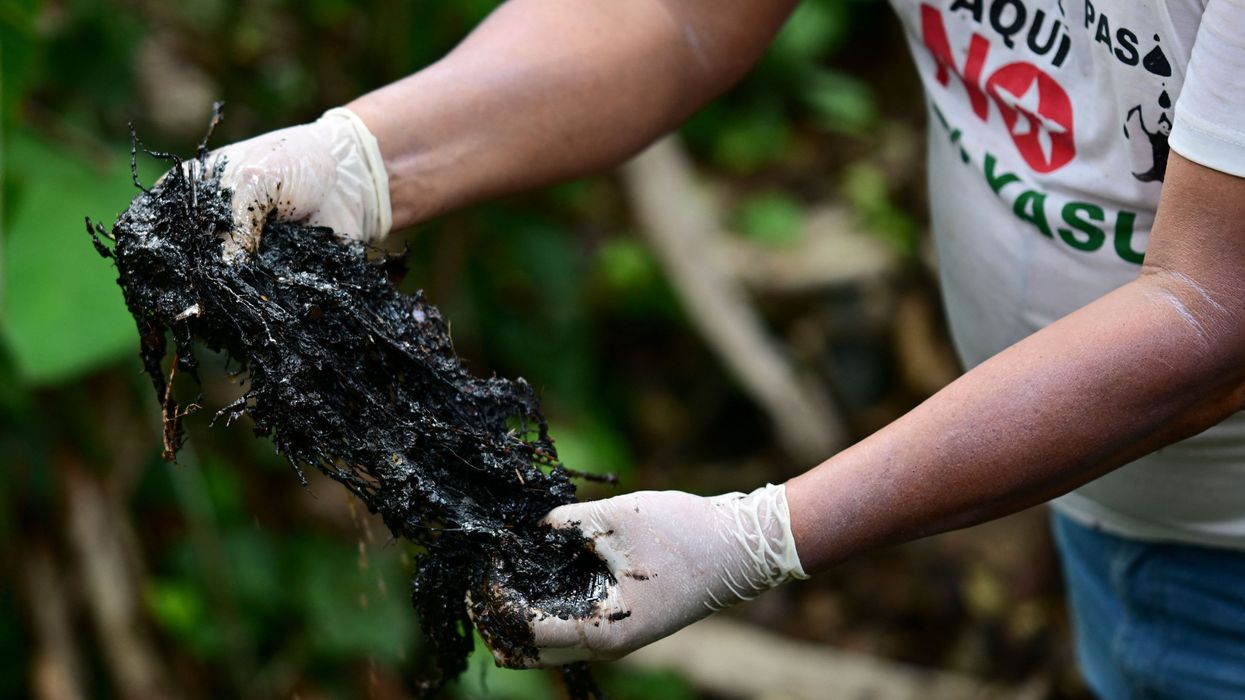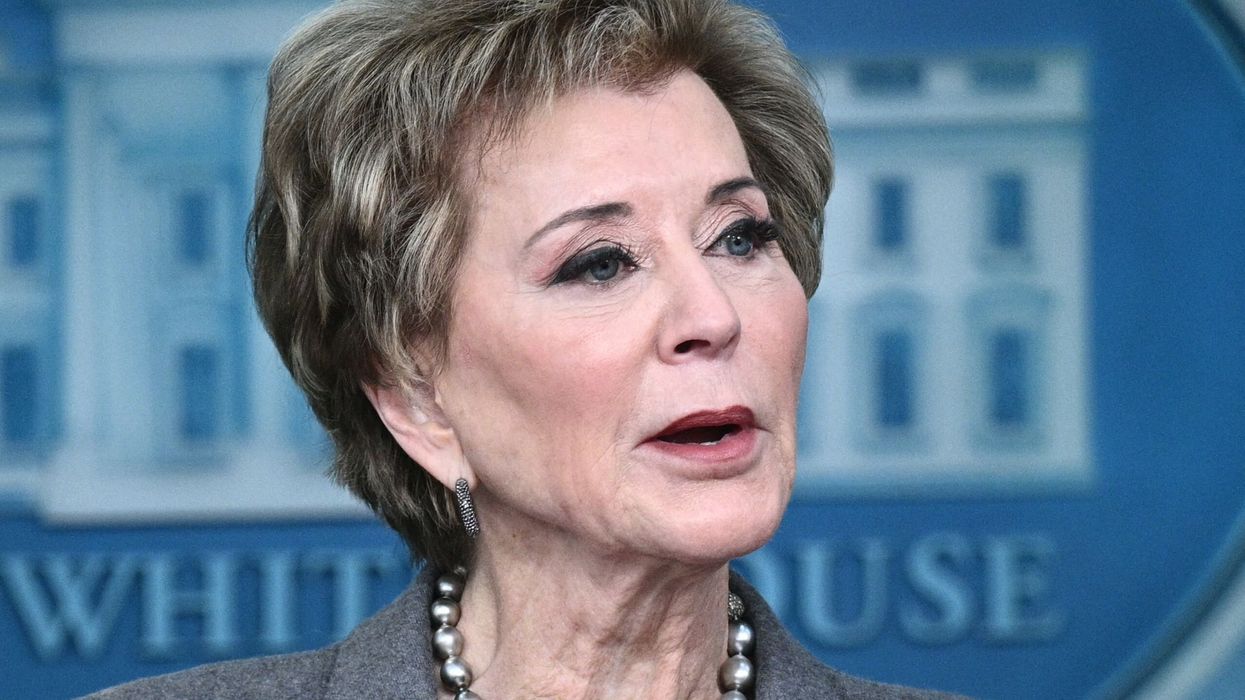January, 20 2012, 04:30pm EDT

Human Carcinogen Found in Drinking Water Near Gas Drilling Ops
WASHINGTON
The federal Environmental Protection Agency's detection of arsenic, a known human carcinogen, barium and other contaminants in the well water of homes near natural gas drilling operations in Dimock Township, Pennsylvania, should prompt a nationwide investigation of drilling-linked water pollution.
" EPA and other officials must move quickly to ensure these families have an adequate source of clean water," said Dusty Horwitt, senior counsel with Environmental Working Group. "This finding confirms what Dimock residents have said for months -- that the Pennsylvania Department of Environmental Protection should have never allowed Cabot to end deliveries of clean water."
Last month, EWG published a report called "Gas Drilling Doublespeak" that found that Dimock residents, among other people in gas-rich areas, were not warned of risks to their water supplies when they were approached to lease their land for drilling.
EPA officials in Philadelphia announced yesterday they would deliver clean water to the four affected households and conduct broader testing at about 60 more homes in south-central area Susquehanna County. Cabot Oil & Gas Corp., the Houston-based company that began drilling for gas in the area in 2008, delivered water to the households under a 2010 consent agreement but stopped Nov. 30 after state regulators determined that Cabot had met its obligations.
According to an EPA action memo released yesterday, agency scientists found the four households' well water contaminated with arsenic and other hazardous substances "at levels that present a public health concern." Some of these "are not naturally found in the environment," EPA officials said, and may have been released by drilling activities. Among the toxic substances found in the well water, according to the EPA:
* Arsenic, classified by the US government and World Health Organization as a known human carcinogen, an element sometimes found in "elevated concentrations" in groundwater because of drilling;
* Barium, a common constituent of drilling fluids; long-term ingestion at high levels can cause kidney damage;
* Phthalates, a synthetic plastic chemical and probable human carcinogen, according to EPA;
* Glycol compounds common in drilling fluids and associated with damage to kidneys, the nervous system, lungs, heart, testicular damage and anemia;
* Manganese, an naturally occurring element that can damage the nervous system at high levels;
* Phenol, found in some drilling fluids; at high levels can cause irregular heartbeat, liver damage and skin burns;
* Sodium, compounds found in some drilling fluids, at high levels can cause high blood pressure.
Federal officials said that although the investigation has not been completed, they have concluded, based on samplings to date, that a "chronic health risk exists" for the wells in question.
"These results also show that the families ultimately need a permanent source of healthy water, which the state has so far failed to deliver," Horwitt said. "Cabot should bear the cost of providing this, not the taxpayers."
The Environmental Working Group is a community 30 million strong, working to protect our environmental health by changing industry standards.
(202) 667-6982LATEST NEWS
'Defeat for Justice': Ecuador to Pay Amazon-Polluting Chevron $220 Million
"A debt is not owed to Chevron. A debt is owed to the Amazonian families still waiting for truth, justice, and full reparation."
Dec 09, 2025
A US advocacy group, American human rights lawyer Steven Donziger, and the group in Ecuador behind a historic legal battle against Chevron over its dumping of toxic waste in the Amazon rainforest are condemning the Ecuadorian government's plans to pay the oil giant hundreds of millions of dollars due to an arbitration ruling.
In response to the legal fight in Ecuador that led to a $9.5 billion judgment against Chevron—which bought Texaco—the fossil fuel company turned to the investor-state dispute settlement (ISDS) system, suing the South American country in the Hague-based Permanent Court of Arbitration. As part of the latter case, Ecuadorian Attorney General Diana Salazar Méndez's office announced Monday that the government would pay the US company only around $220 million, rather than the over $3 billion Chevron sought.
While Chevron said in a statement that it was "pleased with the resolution of this matter" and claimed the decision "strengthened the rule of law globally," and Salazar Méndez's office celebrated the dramatically lower figure, and the Union of Peoples Affected by Chevron-Texaco (UDAPT)—the group that began the case against oil company in 1993—pushed back against the government's framing of the reduction "as if it was a success and an economic achievement."
"The reality is it is a defeat for justice," UDAPT argued in a Tuesday statement. "For 32 years, UDAPT has documented pollution, environmental crime, and lives broken by Chevron, proving what should be obvious: Communities have not recovered, health has not been restored, clean water has not returned, and the territories that sustain life remain contaminated. A debt is not owed to Chevron. A debt is owed to the Amazonian families still waiting for truth, justice, and full reparation."
Amazon Watch deputy director Paul Paz y Miño similarly said Tuesday that "this illegitimate arbitration process is nothing more than Chevron abusing the law to escape accountability for one of the worst oil disasters in history."
"Ecuador's courts ruled correctly and based largely on Chevron's own evidence, that Chevron deliberately poisoned Indigenous and rural communities, leaving behind a mass cancer zone in the Amazon," the campaigner continued. "Adding insult to injury, the idea that Ecuador's people should now pay a US oil company that admitted to deliberate pollution is the epitome of environmental racism."
Ecuadorian President Daniel Noboa "must not honor this ISDS award, and the international community must stand behind the victims of Chevron's crimes and demand that the company clean up Ecuador once and for all," Paz y Miño added. "Amazon Watch stands with the affected Indigenous peoples and communities of the Ecuadorian Amazon. We urge President Noboa to reject this illegitimate award, disclose any negotiations with Chevron, and enforce Ecuadorian law by ensuring Chevron pays its debt to those it poisoned."
Donziger—who was detained in the United States for nearly 1,000 days after Chevron went after him in the American legal system for representing Big Oil's victims in Ecuador—was also sharply critical, saying Tuesday that "the decision by a so-called private corporate arbitration panel that claims to absolve Chevron of its massive pollution liability in Ecuador has no legitimacy and does not affect the historic $9.5 billion damages judgment won by Amazonian communities."
"That judgment still stands as the definitive public court ruling in the case," he said. "The private arbitral panel has no authority over the six public appellate courts, including the Supreme Courts of Ecuador and Canada, that issued unanimous decisions against Chevron and confirmed the extensive evidence that the company devastated local communities by deliberately dumping billions of gallons of cancer-causing oil waste into rivers and streams used by thousands of people for drinking, bathing, and fishing."
"I also strongly condemn President Daniel Noboa for his plans to betray his own people by agreeing to send $220 million from the public treasury to Chevron, a company that owes Ecuador billions under multiple court orders for poisoning vulnerable Indigenous peoples with toxic oil waste," Donziger added. "Noboa would effectively grant Chevron a taxpayer-funded bailout financed by the same citizens who remain victims of the company's pollution. This would be an outrageous dereliction of duty and a violation of his oath of office, warranting removal."
Keep ReadingShow Less
After Judge Tosses GOP Lawsuit, Missouri Voters Submit Signatures for Referendum on Rigged Map
"The citizens of Missouri have spoken loudly and clearly: They deserve fair maps, not partisan manipulation,” said one campaigner.
Dec 09, 2025
Opponents of Missouri's GOP-rigged congressional map on Tuesday submitted more than twice the required number of signatures supporting a referendum on the redistricting scheme backed by US President Donald Trump, a move that followed a federal judge's refusal to block the initiative.
The political action committee People Not Politicians turned in more than 300,000 signatures in support of the referendum to Republican Missouri Secretary of State Denny Hoskins' office in what the group called an "unprecedented show of grassroots power."
The submission—which filled 691 boxes—will be reviewed by state election officials tasked with certifying the validity of the roughly 110,000 signatures required for qualification on the November 2026 ballot. If the signatures are approved, the state would be temporarily prohibited from adopting the new map until after the referendum vote.
Hoskins initially rejected People Not Politicians' referendum petition because Missouri Gov. Mike Kehoe, a Republican, had not yet signed the redrawn map into law. Hoskins said he would reject any signatures collected before Kehoe approved the map in September. At that time, People Not Politicians had collected around 92,000 signatures.
“The citizens of Missouri have spoken loudly and clearly: They deserve fair maps, not partisan manipulation,” People Not Politicians executive director Richard von Glahn said in a statement. “We are submitting a record number of signatures to shut down any doubt that Missouri voters want a say.”
The submission followed a Monday ruling by US District Judge Zachary Bluestone—a Trump appointee—rejecting Republican Missouri Attorney General Catherine Hanaway's bid to block the referendum on grounds that the court had no jurisdiction over a lawsuit filed by Hoskins and the GOP-controlled state Legislature arguing that state referendums on congressional maps are unconstitutional.
Supporters of Missouri's referendum are seeking to block redistricting legislation passed in September as part of Trump's push for Republican-controlled state legislatures to rig congressional maps in a bid to preserve GOP control of Congress by eliminating Democratic-leaning districts.
Texas was the first state to do Trump’s bidding by approving a new congressional map that could help Republicans gain five additional House seats. Last week, the US Supreme Court's right-wing majority gave Texas Republicans a green light to use the rigged map in next year's election.
Democratic California Gov. Gavin Newsom responded to Texas' move by spearheading a successful ballot initiative to redraw the Golden State's congressional map in favor his party. Under pressure from Trump, Republican lawmakers in Indiana, Missouri, and North Carolina launched their own gerrymandering efforts.
In Missouri, Republicans are aiming to win seven of the state's eight congressional seats, including by flipping the 5th District, which is currently held by Democratic Rep. Emanuel Cleaver.
Responding to Tuesday's signature submission, Missouri state Rep. Ray Reed (D-83) said on social media that "today, the people of Missouri did something powerful. Organizers across our state: young folks, retirees, faith leaders, neighbors talking to neighbors, came together to defend the idea that in a democracy, voters should choose their leaders, not the other way around."
"Missouri just showed the country what fighting back looks like and I’m proud to stand with the people who made it happen," Reed added.
Keep ReadingShow Less
Trump's Billionaire Education Secretary Makes 'Backroom Deal' to Shaft Low-Income Borrowers
Amid a cost-of-living crisis, millions of low-income borrowers may now be forced to spend several hundred more dollars a month paying for student loans.
Dec 09, 2025
As student debt exacerbates the financial struggles of millions of Americans, the Trump administration has taken a major step toward killing the Biden administration's student loan forgiveness program.
On Tuesday, the Department of Education announced that it had reached a settlement with the state of Missouri to end the Saving on a Valuable Education (SAVE) program, which allowed more than 7 million mostly low-income Americans to reduce their federal student loan payments.
Rather than setting monthly payments based on income, the SAVE program bases them on how much borrowers earn and the size of their families, which is referred to as an income-driven repayment option, or IDR. SAVE cut most enrollees' monthly loan payments in half and left 4.5 million of them, mostly those earning between 150–225% of the federal poverty level, paying $0 per month.
In March 2024, a coalition of 11 states led by Kansas Attorney General Kris Kobach sued in federal court to stop the SAVE plan. The next month a similar lawsuit was filed by another coalition of seven states led by Missouri's former attorney general, Andrew Bailey.
In February, the 8th Circuit Court of Appeals ruled in favor of the states, blocking 8 million borrowers from accessing lower payments under the program. Now President Donald Trump's administration which aggressively opposes student loan forgiveness, has agreed to settle the lawsuit, effectively killing SAVE.
“For four years, the Biden administration sought to unlawfully shift student loan debt onto American taxpayers, many of whom either never took out a loan to finance their postsecondary education or never even went to college themselves, simply for a political win to prop up a failing administration,” said Undersecretary of Education Nicholas Kent. "The Trump administration is righting this wrong and bringing an end to this deceptive scheme. The law is clear: if you take out a loan, you must pay it back."
The settlement also includes a provision requiring that, for the next 10 years, the Department of Education notify the state of Missouri at least 30 days in advance before instituting broad-based student debt relief.
As the Debt Collective, a membership-based debtors' union, explained in a post on social media: "30 days is enough notice that Missouri will find standing to sue for relief before it even happens. So not only is Trump gutting the SAVE plan, they're essentially putting a moratorium on cancellation for the next 10 years with this agreement."
"What Republicans admit is that the executive administration does have authority to cancel federally held student debt," the group added. "They just want to make it so that it will be administratively and practically impossible to deliver it because of this technicality. It's stealing in advance."
SAVE was already slated to end in 2028 following July's passage of Republicans' One Big Beautiful Bill Act, which replaced it with a pair of less generous income-based repayment plans that require many debtors to pay hundreds more per month. The deadline to switch to one of the new plans will now move up, though the administration has not yet clarified when borrowers will have to switch.
The Debt Collective predicted that the end of SAVE "means many more debtors will likely be forced to default on their loans," which the group added "is bad for millions of families and our economy."
According to an analysis of federal student loan data from the American Enterprise Institute, a libertarian think tank, more than 12 million borrowers in the US are already in default or otherwise behind on their student loan payments.
Since their introduction, former President Joe Biden's student loan forgiveness policies have been chipped away at bit by bit through litigation. In 2023, the conservative US Supreme Court struck down the administration's plans to forgive up to $20,000 in student loan debt for millions of Americans, ruling that the plan exceeded the administration's executive authority. A year later, it halted SAVE as well while it considered the merits of the Missouri lawsuit.
The group Protect Borrowers, which supports student loan forgiveness, argues that SAVE is "not a novel use of executive power," noting that Congress gave the Education Department the authority to create IDRs in 1993 and that several other programs have been created since.
"This settlement is pure capitulation—it goes much further than the suit or the 8th Circuit order requires," said Persis Yu, the group's deputy executive director and managing counsel. "The real story here is the unrelenting, right-wing push to jack up costs on working people with student debt.”
A September survey by Data For Progress found that student loans make it more difficult for many borrowers to keep up with other bills amid a growing cost-of-living crisis: 42% of respondents said their debt payments had a negative impact on their ability to pay for food or housing. More than a third, 37%, said it had a negative impact on their ability to cover healthcare costs for themselves or their dependents, while the majority, 52%, said it had a negative impact on their ability to save for retirement.
“While millions of student loan borrowers struggle amidst the worsening affordability crisis as the rising costs of groceries, utilities, and healthcare continue to bury families in debt," Yu said, "billionaire Education Secretary Linda McMahon chose to strike a backroom deal with a right-wing state attorney general and strip borrowers of the most affordable repayment plan that would help millions to stay on track with their loans while keeping a roof over their head."
Keep ReadingShow Less
Most Popular


